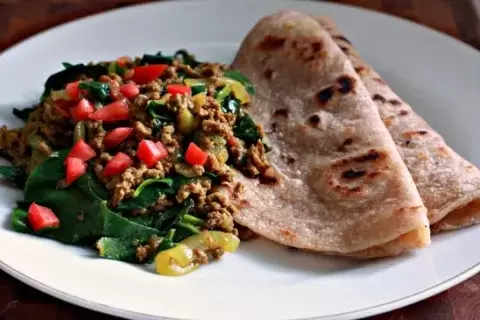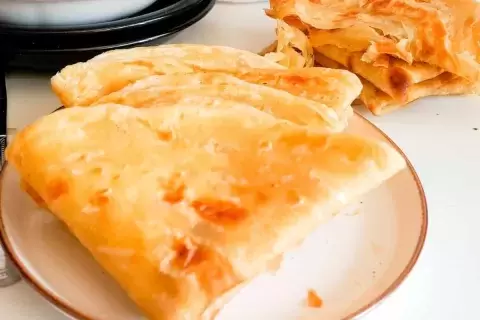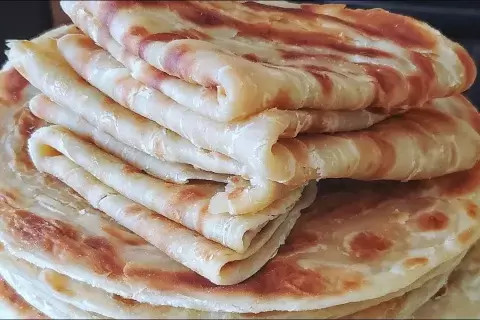Chapati and Sukuma Wiki are two popular and complementary dishes that are widely enjoyed in East African cuisine, particularly in countries like Kenya and Tanzania.
Chapati is a flatbread made from wheat flour, water, salt, and sometimes oil. It is rolled thin, cooked on a hot griddle or skillet, and lightly brushed with oil or ghee. The result is a soft, flaky, and versatile bread that pairs well with a variety of dishes.
Sukuma Wiki, on the other hand, is a Swahili phrase that translates to "stretch the week." It refers to a dish made from collard greens or kale, sautéed with onions, tomatoes, and spices such as garlic and chili. Sukuma Wiki is often cooked until the greens are tender and served as a nutritious and economical side dish.
Together, Chapati and Sukuma Wiki create a harmonious combination—a hearty and satisfying meal that balances the warm, pillowy bread with the flavorful and nutritious greens. This duo is not only a culinary delight but also represents the resourcefulness and creativity of East African cuisine in making the most out of humble ingredients.
Introduction
Kenyan cuisine is a vibrant fusion of flavors and cultural influences. One of the most beloved dishes in Kenya is the combination of Chapati (a traditional flatbread) and Sukuma Wiki (a delicious collard greens dish).
This delightful pairing is not only easy to prepare but also packs a punch in terms of taste and nutritional value.
Join me on this culinary journey as we explore the recipe, ingredients, preparation, serving suggestions, and cultural significance of Chapati and Sukuma Wiki.
Recipe: Chapati
Ingredients:
- 2 cups all-purpose flour
- 1 teaspoon salt
- 1 cup warm water
- 2 tablespoons vegetable oil
- Extra flour for dusting
Preparation:
- In a large mixing bowl, combine the all-purpose flour and salt.
- Gradually add the warm water to the flour mixture and knead until you have a soft, pliable dough.
- Drizzle the vegetable oil over the dough and knead again until the oil is well incorporated.
- Divide the dough into small, golf ball-sized portions.
- Dust a clean surface with flour and roll out each portion into a thin, circular shape using a rolling pin.
- Heat a skillet or tawa over medium heat.
- Place a rolled-out chapati on the skillet and cook until bubbles start to form on the surface.
- Flip the chapati and cook the other side until golden brown spots appear.
- Remove from heat and repeat the process with the remaining dough portions.
- Serve warm and enjoy!
Special equipment:
Rolling pin, skillet or tawa
Recipe: Sukuma Wiki
Ingredients:
- 1 bunch sukuma wiki (collard greens), washed and chopped
- 1 medium onion, finely chopped
- 2 tomatoes, chopped
- 2 cloves garlic, minced
- 1 tablespoon vegetable oil
- 1 teaspoon curry powder (optional)
- Salt and pepper to taste
Preparation:
- Heat the vegetable oil in a large pan or skillet over medium heat.
- Add the chopped onions and sauté until translucent.
- Stir in the minced garlic and cook for another minute.
- Add the tomatoes and cook until they soften.
- If desired, add curry powder for an extra flavor dimension.
- Toss in the chopped sukuma wiki and season with salt and pepper.
- Cook the mixture, stirring occasionally, until the collard greens wilt and become tender.
- Remove from heat and transfer to a serving dish.
Serving Suggestions
Chapati and Sukuma Wiki complement each other perfectly. Serve them together for a wholesome and delicious meal. Alternatively, you can enjoy Chapati with various curries, stews, or even as a wrap with your favorite fillings.
Sukuma Wiki pairs well with rice, Ugali (maize meal), or as a side dish alongside grilled meat or fish.
Nutritional Value
Chapati provides a good source of carbohydrates, proteins, and dietary fiber from the flour. It also contains essential vitamins and minerals.
Sukuma Wiki, made with collard greens, is rich in vitamins A, C, and K, as well as folate, calcium, and iron. Together, these dishes offer a balanced and nourishing meal.
Cultural & Traditional Value
Chapati and Sukuma Wiki hold great cultural and traditional significance in Kenya. Chapati is believed to have been introduced to the country by Indian traders and has become a staple in Kenyan cuisine.
It is often prepared during special occasions and celebrations, showcasing the country's diverse culinary heritage. Sukuma Wiki, on the other hand, translates to "stretch the week" in Swahili and signifies the resilience and resourcefulness of Kenyans, who use collard greens to make their meals last longer.
Conclusion
Cooking Chapati and Sukuma Wiki allows us to savor the flavors of Kenyan cuisine while appreciating the cultural and traditional significance of these dishes.
Whether you're looking to experience the taste of Kenya or simply expand your culinary repertoire, this delightful combination is a must-try. So gather the ingredients, roll up your sleeves, and enjoy the deliciousness that Chapati and Sukuma Wiki have to offer!
















